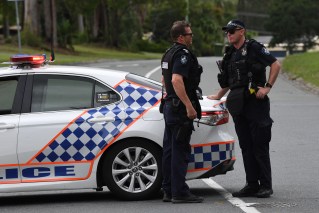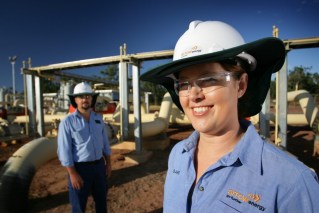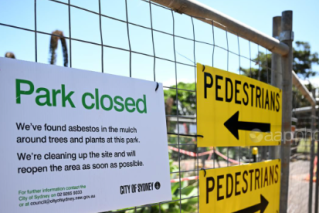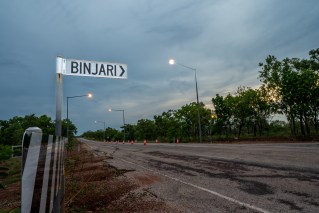The forgotten Queensland communities forced into do-it-yourself broadband
Digital technology is tipped to be the engine to drive economic growth for regional Australia in the next decade, but there’s a disconnect between what’s promised and the current reality for business owners in the bush.

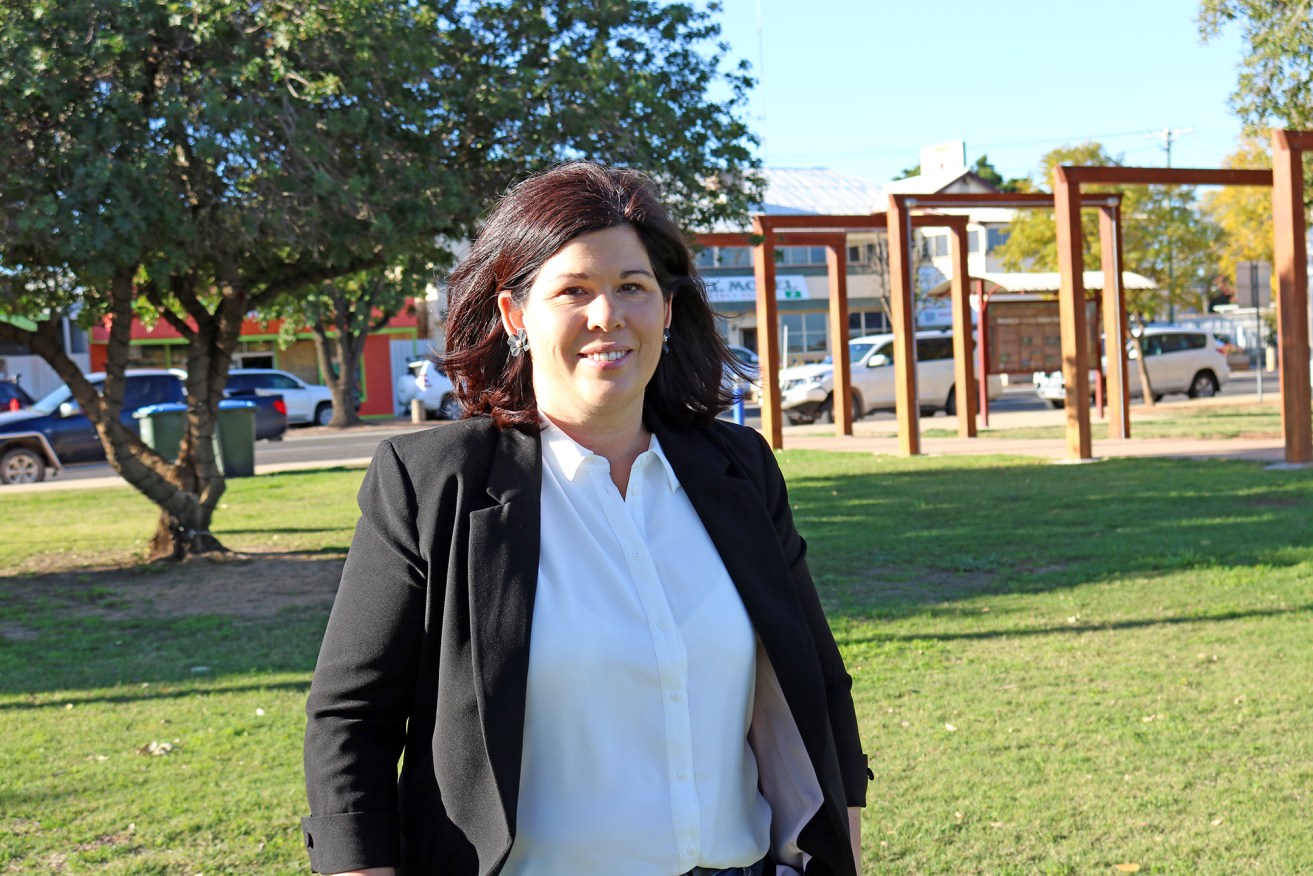
Balonne Shire Mayor Samantha O'Toole in the border town of Dirranbandi.
In places like Balonne Shire in the state’s southwest, they are trying to stitch together a digital patchwork that will cover their community with enough data to drive their homes, businesses, facilities and farms.
Two years in the making and funded by piecemeal grants tallying more than $3 million, the project is expected to go live before Christmas, finally delivering stable internet for the main town of St George in the Balonne Shire.
Surrounding shires such as Bulloo, Paroo, Murweh and Maranoa are also doing the same, using Building Our Regions funding from the State Government, and augmented by various other sources of grant money, to tap into high-speed fibre that runs into Sydney that is then redistributed across the region via a network of towers dotting the landscape.
In Balonne, it’s meant the construction of 12 towers at a cost of more than $3 million, sourced from Building Our Regions, Murray Darling Regional Economic Development funding and support from their consulting partner, Field Solutions Group.
Even the NSW Government has tipped in coin to ensure the community of Mungindi across the border also doesn’t miss out.
“Our goal is to 100 per cent saturate our shire with symmetrical, high speed internet,” Balonne Mayor Samantha O’Toole explained to InQueensland.
“Both data connectivity and mobile coverage is equally bad out here, but through extensive consultation with the Balonne community we’ve prioritised internet coverage.
“From an economic development and business point of view, it made sense to go with digital.
“Currently if you’re a business owner or farmer in St George you are struggling with slow internet speeds to run your business.”
O’Toole’s assessment is an understatement. In the shire’s main business district of St George, internet coverage will randomly cut in and out, fluctuating between different locations without explanation, locals say.
This is a town where the National Broadband Network virtually doesn’t exist, with St George effectively not included on the network’s map, leaving residents and business owners to resort to fixed wireless, which has its limitations.
It’s a town of nearly 2500 people, one of the south-west’s major service centres in a region of 24,000 people, home to the Cooper and Eromanga resource basins – the largest onshore petroleum province in Australia.
It’s also known for irrigated cotton farming, beef and sheep production and gemstone mining, all combined contributing $2.92 billion to gross regional product each year.
O’Toole says businesses are challenged by storing files. Even the local medical centre can’t file patient records electronically for fear the unstable connectivity will cause data to go missing.
In many cases it’s easier and more reassuring to use the fax machine.
While O’Toole is looking forward to flicking the switch on their local digital project, she’s disappointed it has taken the efforts of local councils to find a solution using some out-of-the-box thinking and some country ‘can-do’.
“For such a critical piece of infrastructure we really shouldn’t have to be doing this ourselves,” she said.
“You would think that our three levels of government would work together in a coordinated way to ensure we have the data where and when we need it – not just for our region but rural regions generally.”
O’Toole’s comments come a week after federal communications minister Paul Fletcher announced a $3.5 billion upgrade to the nation’s National Broadband Network (NBN) based on a large fibre roll-out that will go much closer to homes and businesses.
What this means for rural and remote Australia remains to be seen, especially as the country’s information super highway has been running at variable speeds – generally faster in the city, slower in the bush – for decades.
The launch in April of Sky Muster Plus, the upgraded satellite internet service for rural areas, was meant to provide more consistent coverage and stronger bursts of data speed to remotely located Australians.
O’Toole is not convinced, describing the service as a “joke” for her region.
NBN on right track
In the north of the state, long-time campaigner for better internet services, Kylie Stretton, is confident the bush is finally getting the coverage it needs to do business.
Even as little as four years ago, Stretton was a regular face at meetings and forums throughout the State, thumping the table for data connectivity on par with city-like speeds, commensurate with the size and scale of rural industry and the contribution it makes to the broader economy.
That was when Stretton and her family lived only 20km outside Charters Towers.
These days they’re on a far more remote beef holding 130km from the town west of Townsville and the difference in quality between then and now, she says, is lightyears apart.
Even this year, operating a farm, running a livestock agency business with husband Shane, and home-schooling children, their internet service didn’t miss a beat.
“I’m not saying it’s always perfect and that there’s not more to improve, but it’s been a massive turnaround in terms of the amount of data we can now access,” she said.
“The NBN is on the right track.”
Stretton says even roaming data around their 5000-hectare property is proving solid, with the couple recently trialing “virtual fencing” on their operation, a process that requires collar-mounted GPS devices to contain animals within an area.
The collars emit an audio tone as the animal approaches the virtual fence line. If the animal continues forward, an electrical pulse is applied.
Stretton wants to continue the practice for the animal welfare benefits and the labour and cost savings on building and maintaining physical fence structures, but the technology still needs refining.

Beef producer Kylie Stretton, with daughter Elle-Beth in northwest Queensland.
“But that wasn’t the fault of the internet,” she says. “I believe the internet is available for farmers who want to continue introducing more automation and hi-tech tools to their businesses.
“What we’re finding is that the technology is now there. The media generally seems to be stuck on an old script that the bush is suffering from deficient internet.
“That makes farmers feel like the situation is hopeless, when, in fact, they just need the information on how to access the data.”
Farming’s digital future
Stretton’s experience aligns with an NBN commissioned report released last month showing that by 2030 internet-enabled technologies could add $15.6 billion, an increase of 20 per cent, to the farming, forestry and fishery sectors’ gross value of production each year.
Increased adoption of digital agriculture on-farm is essential to the industry achieving its objective of being Australia’s next $100 billion industry.
NBN’s head of regional development, Gavin Williams, said that with poor connectivity estimated to cost farmers up to $5 a hectare, the availability of services over the NBN could help enable the realisation of digital agriculture across Australia.
“We know access to fast and affordable broadband not only helps overcome the tyranny of distance, but is a major enabler for economic growth for those who make a living from the land,” Williams said.
“To help Australian farmers take full advantage of the digital opportunity we are collaborating closely with the agricultural sector to design connectivity solutions that support these emerging technologies.
“This is all about helping to enable success, and we want to go beyond improving productivity and growth on the farm to see improvements to community wellbeing across regional Australia as well.”
Pandemic-fuelled growth
Coronavirus restrictions that are disrupting food supply chains and challenging farming operations with labour shortages and border closures are also accelerating the move to higher-tech farming tools.
Leading University of Queensland academic Professor Robert Henry said the technologies – commonly grouped under the term “agtech” – had all been in various stages of planning prior to COVID-19, but food producers would now be moving much faster to prepare for the next pandemic.
“Food processing facilities like meatworks have had to close due to a staff member being infected with the coronavirus, and all food processing industries where you have workers in small confined spaces are similarly at risk,” Henry said.
Henry, who is the director of the Queensland Alliance for Agriculture and Food Innovation (QAAFI), said roboticised abattoirs and automated harvesting and production facilities would also reduce the risk of transmission of pathogens among workers but also the spread of viruses via the food itself.
“COVID does not seem to be transmissible from an infected human touching food but a future pandemic virus might be transmitted this way, so automating the food supply chain reduces this risk,” he said.
It also minimises reliance on human workers that are not available due to migration restrictions and border closures.
“Advanced technologies need to be adopted globally, in each region, to deliver local food production capability that could provide secure sources of food in future pandemics.
He said increased investment in agricultural research and development would support enhanced food security.
It appears governments are listening.
The Queensland Government has opened applications under a new grant program to help agribusiness recover from COVID-19 through digital transformation.
Agriculture Minister Mark Furner said $1.2 million was available for industry organisations in round one of the Agribusiness Digital Solutions Grant Program.
It follows the Australian Government welcoming an independent report commissioned by the chief scientist Dr Alan Finkel AO that supports an increased uptake of emerging technologies across our agriculture, forestry and fisheries industries.
Agriculture Minister David Littleproud said the Australian Council of Learned Academies’ (ACOLA) report would help to inform the development of key outcomes under the National Agricultural Innovation Agenda announced on September 1.
“This comprehensive body of work makes it abundantly clear that strategic investment in the development of new tech is critical if agriculture is to stay ahead of the game,” Littleproud said.
“Australian farmers already have some of the most advanced farming practices in the world, and the findings of this report confirm the importance of ensuring farmers and businesses on-farm have easy access to innovative technologies into the future along the supply chain.
“The future for our sector is very exciting.”

